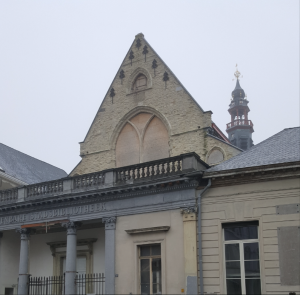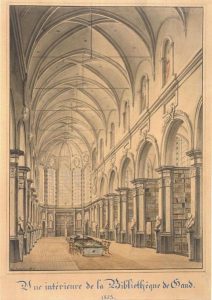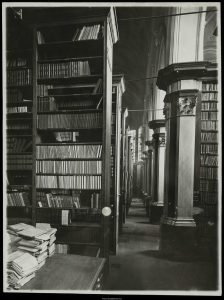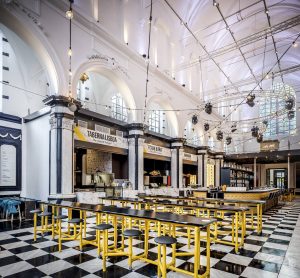Champagne and croquettes are served to a public of hipsters in an ecclesiastical setting where once monks contemplated and served the Lord. After some years of quiet decay, abandoned and at the edge of contemporary city life, the church of Baudelo Abbey in Ghent, Belgium, is rejuvenated.

Image of the interior
Black and white marble join contemporary interior design with the eighteenth century outline of the building. A fashionable checkered floor hiding the new heating system complements the ionic capitals and black architraves. Baudelo Abbey is a testimony of monastic architecture during the Counter-Reformation in modern day Belgium. The original Cistercian abbey was founded in the early twelfth century near Klein Sinaai – an allegorical desert to the north-east of Ghent. During the years of the Calvinist Ghent Republic (1577-1584) both the abbey and its refugium within the city walls were destroyed. Some years after the fall of the City Republic the monks returned from their exile in Cologne. A new abbey was built on the site of the earlier refugium. The church was constructed in a late Gothic style in the early seventeenth century and underwent an internal redesign by Pieter van Reijsschoot in the second half of the eighteenth century. The recent reactivation of the redundant Baudelo Abbey church follows a redesign as a library in the early nineteenth century. After the abolition of monastic orders in Flanders in 1795, the church shortly inhabited a temple of reason before becoming the location of the central library. Books from all monastic institutions were gathered and displayed in the abandoned building forming the core of the later Ghent University Library. The interior is redesigned to house the books, the Van Peteghem organ, once played by a young Mozart during his visit of Ghent in 1765, was sold. On the outside a new portico in a neoclassical style was added in 1817. However, most of the late building dating back to the early seventeenth century survived, including the turret and its carillon by Hemony. Other parts of the former abbey were reused as a school, a function these buildings hold up to this day. The rest of monastic estate became a botanical garden and is currently undergoing a make-over to a contemporary city park.
Champagne and croquettes are served today to a congregationwhere once wine and host was handed out to monks. Baudelo Abbey in Ghent has recently become a sparkling hub for hipsters, after years of silent decline the abbey church of St. Bernard in Ghent, Flanders, is rejuvenated and once again a place for gathering. Not for monks or anyone following the Order of St. Benedict, but for foodies and hipsters bringing back life to this historic building. Two centuries have passed since the last monks left the premises and for many decades this former house of worship hosted the university library. Yet for some decades the building had been abandoned, a silent witness of a troubled past, hidden in a corner waiting for a rebirth. The author remembers parties being held in the church during the Ghent Festival some fifteen years ago. A unique but temporary experience.

The history of the Cistercian Abbey of Baudelo goes back to the twelfth century. Leaving city life behind him, Boudewijn van Boekel of Ghent went into the desert following a centuries old monastic tradition. The closest equivalent of a desert in the county of Flanders at that time was a place located to the north-east of Ghent today called Little Sinaai. His foundation grew quickly and became an important stronghold of the Cistercian Order in the county. Probably the best known figure from Baudelo Abbey is Willem, the thirteenth century author Van den Vos Reynaerde. The epic tales of a cunning fox later inspired people like Chaucer, Shakespeare and Goethe. In 1578 the abbey fell victim to Calvinists of the Ghent Republic, the monks went in exile to Cologne, Germany, and the buildings were raised to the ground.
After the troubles of the sixteenth century had finally come to an end, the monks returned to Flanders from exile. It was decided to rebuilt the abbey in Ghent, on the site of their original thirteenth century Refugium which had been demolished during the years of the Ghent Republic. The new Abbey Church of St. Bernard, built between 1602 and 1616, is an example of monastic Gothic architecture of the early seventeenth century, a testimony this style was never completely abandoned. An elegant turret was added some fifty years later, supporting a carillon by Hemony. In the eighteenth century the building received most of its current interior, an elegant neoclassical redecoration in black and white marble executed by local architect Pieter van Reysschoot. In 1765 a young Mozart played on the new organ during his father’s tour of the Low Countries. The organ by Van Peteghem from 1763 was ultimately sold in the early nineteenth century. In the aftermath of the French Revolution Baudelo Abbey, as other monastic institutions in Ghent, was abolished in 1795. For a short period the church functioned as a Temple of Reason, but the success of this cult was limited.

St. Bernard’s Church housing the university library in 1853 – collection Ghent University library
The abandoned buildings were soon occupied by new inhabitants. Students replaced monks as the monastic houses became a school, the estate was converted to a botanic garden and the Church of St. Bernard became a library. Books form all monastic libraries in the city were put together and created what would soon be the foundation of the Ghent University Library. Among the most exceptional pieces are some books of the Ghent school of illuminations and manuscripts such as the Liber Floridus of 1120. Then in the wake of modern architecture a new University Library was conceived and built to the designs of Henry van de Velde. His vision, a concrete formation, is sometimes dubbed the fourth tower of Ghent. After the Second World War St. Bernard’s Church continued as the municipal library, until the books were moved to an abandoned modernist building in a more central location of the city.

Books in the aisles – collection Beeldbank Stad Gent
For years the former abbey church stood vacant, in an otherwise vibrant part of town. Plans to use the church as a stage for plays and musical performances of the adjacent art school, housed in the other buildings of the former Cistercian foundation, were abandoned due to a lack of funds. The building looked fine, a bit neglected but nothing alarming. Some people, including the author, will remember dancing nights inside the chapel during the Ghent Festival at the turn of the century. Then signs of neglect, recurrent at vacant structures, began to appear. Parts of the vaults were in a bad state and scaffolding was placed inside the church. Externally the wooden turret showed signs of neglect and was restored in 2006. Years passed until in 2015 the building was bought by Trobo NV with plans to convert it to a food market. Baudelo Abbey, since 1936 a listed heritage site including the church of St. Bernard, was renovated and converted in a close cooperation of the architect, a structural engineer and the city’s department for monument preservation.
In February this year, after months of anticipation, the abbey church re- opened its doors, now staging a food market. Originally this was planned for late 2015 but problems with the vaults seemed to have worsened and a stability renovation was needed, ultimately delaying the opening of the food market. Another challenge was the heating. Churches are rarely comfortable places during the cold winter months, a solution had to be found to maintain a comfortable temperature inside the classified church during all seasons. A heating system was installed, hiding under the floor, and covered under a new marble tiles evoking the original eighteenth century interior decoration. The design are by King George Concept, executed by Geert van Beeck of Leuven. A fashionable black and white theme with an abundance of marble was a logic choice regarding the garnishing by Pieter van Reijsschoot already there. Both aisles are now filled by food booths, fifteen in total, whereas the nave remains the location for the benches and a large oval bar. However, the anticipated meal is not spiritual or retained to bread and wine, today G&T, champagne and special beers are served at the bar and the chapels offer a wide range of delicatessen from trendy avocado dishes to Russian – Kazakh cuisine.

Baudelo Abbey is a vibrant example redesign for adaptive reuse can safeguard religious heritage. The monastic gardens were adapted to the contemporary desires in the nineteenth century and today again redesigned for current needs. Since its abolition in 1795 the church of St. Bernard was reused as a Temple of Reason, a sanctuary for books and today a hipster hub for food aficionados. Adaptive reuse has safeguarded the building which today is a rare survivor of a monastic church of the Counter-Reformation in Flanders in the Gothic style. The contemporary Jesuit college and chapel of St. Lieven in Ghent was demolished in 1799, erasing this part of local history visually, whereas Baudelo Abbey was revitalized with new purposes. Adaptive reuse involves a redesign. This can be regarded an addition of new layers of meaning reflecting our age rather than a transformation of the building. The conversion of the church into a food market thus becomes a contemporary layer adding to the history and heritage of the site.
Written by Marcus van der Meulen.
Marcus van der Meulen researches reactivation of religious buildings as a preservation strategy and studies church interiors. He is a member of the Centro Studi Ghirardacci, Bologna University, the Society for Study of the Church Interior and member of the FRH Network Committee.
References:
https://www.geertvanbeeck.com/copy-of-work
https://inventaris.onroerenderfgoed.be/erfgoedobjecten/25508
http://www.nieuwsblad.be/cnt/dmf20170224_02748533
http://www.ugentmemorie.be/artikel/universiteitsbibliotheek
http://www.waterwijk.be/geschiedenis/merkwaardigheden/de-baudelokapel/





Follow us: